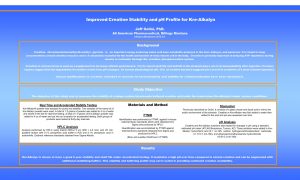
Third Research Article Published As AAP Moves Into A New Phase Of In-House, Cancer-Related Research
January 13, 2015
Science For Humans #1595: Carbohydrates – Friend or Foe
March 4, 2015Improved Creatine Stability and pH Profile for Kre-Alkalyn
Jeff Golini, Ph.D.
All American Pharmaceutical, Billings, Montana
J Biosens Bioelectron 2015, 6:4
Background
Creatine (N-(aminoiminomethyl-N-methylglycine) is an important energy producing amino acid base metabolite produced in the liver, kidneys, and pancreas. It is found in large concentrations around skeletal muscles and is it absolutely essential for the health and function of every muscle cell in the body. Creatine is pivotally important in delaying ATP depletion during anoxia or ischemia through the creatine- phosphocreatine system.
Creatine in various forms is used as a supplement to increase athletic performance. Yet, its stored shelf life and half-life in the stomach play a role in its bioavailability after ingestion. Previous reports suggest that the degradation of creatine results from pH changes. At normal physiological pH, 10% of creatine has been suggested to convert to creatinine, its most common byproduct.
Various modifications to creatine intended to increase its bioavailability and stability for commercialization have been attempted.
Study Objective
The objective of this study was to assesses the stability of a unique sodium bicarbonate buffered creatine sold under the brand name Kre-Alkalyn® under various conditions.
Materials and Method
Real Time and Accelerated Stability Testing
Kre-Alkalyn® powder was assayed for purity and stability. Two samples of the same lot of Kre-Alkalyn® powder were used. A total of 1.5 grams of powder was added to 4 oz of water and stored in the lab for real time testing. A total of 1.5 grams of Kre-Alkalyn powder was added to 4 oz of water and put into an incubator for accelerated testing. Both groups of products were tested at thirty-day intervals.
HPLC Analysis
Analysis performed by HPLC using Inertsil ODS-2 5 µm (250 × 4.6 mm) and 25 min. gradient elution with 0.1% phosphoric acid buffer in H20 and 0.1% phosphoric acid in acetonitrile. External reference standards obtained from Sigma-Aldrich.
FTNIR
Identification was performed by FTNIR, against in-house external library standards which were obtained from Sigma and produced by HPLC. Quantification was accomplished by FTNIR against external library standards obtained from Sigma and produced by HPLC (Bran and Luebbe InfraProver II FTNIR).
Stomacher
Previously described by Golini, it consists of a glass vessel and liquid acid to mimic the acidic environment of the stomach. Creatine or Kre-Alkalyn® was first added to water then added to the acid and pH was assessed over time.
pH Analysis
Creatine and Kre-alkalyn® solutions were tested for changes in pH using a standard calibrated pH meter (ATLAS Bioscience; Tuscon, AZ). Three solutions were added to Kre-Alkalyn®; hydrochloric acid (0.1 ml-1M), sodium hydrogencarbonate/sodium carbonate (11.7/13.7 (ml-1M)), and ethanolamine/ethanolamine hydrochloride (18.6/ 6.3 (ml-1M)).
Results
Kre-Alkalyn® is shown to have a good 6 year stability and shelf life under accelerated testing. It maintains a high pH over time compared to normal creatine and can be augmented with additional stabilizing buffers. This stability and buffering profile may serve useful in providing continued creatine availability.
Research Poster Presentation Image:



